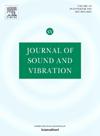The significance of soil–structure interaction in the response of buildings to ground-borne vibration from underground railways
IF 4.3
2区 工程技术
Q1 ACOUSTICS
引用次数: 0
Abstract
The response of buildings to ground-borne vibration is governed by many physical phenomena. Not least of these is the dynamic soil–structure interaction (SSI) that exists between the various components of the system. The majority of existing models assume that the interaction between a railway tunnel and a building’s foundation is negligible, with the two sub-systems behaving as though they are uncoupled; other components of SSI associated with the foundation and building are accounted for to varying degrees, often with little justification. This paper aims to further our understanding of the SSI between an underground railway tunnel and a nearby building. The response of a typical multi-storey building founded on piles is considered, over the frequency range typically associated with perceptible vibration. A comprehensive numerical model is used to capture the fully-coupled, three-dimensional behaviour of the tunnel–foundation–building system, to investigate the relative significance of four fundamental components of SSI when predicting the overall vibration levels within the building. The effects of building location, relative to the tunnel, pile length and foundation configuration are investigated. Three further building models, of varying complexity, are used to explore the extent to which simplified models can capture the fundamental SSI of the system. The conclusions appear promising for the development of simplified models, particularly those aimed at making overall or relative predictions of building vibration levels to guide the design of mitigation measures.
土壤-结构相互作用在建筑物对地下铁路产生的地面振动的响应中的重要性
建筑物对地基振动的响应受许多物理现象的影响。其中最重要的是系统各组成部分之间存在的动态土壤-结构相互作用(SSI)。现有的大多数模型都假定铁路隧道与建筑物地基之间的相互作用可以忽略不计,两个子系统的行为就好像它们是不耦合的;而与地基和建筑物相关的 SSI 的其他组成部分则在不同程度上被考虑在内,但往往缺乏合理性。本文旨在进一步了解地下铁道隧道和附近建筑物之间的 SSI。本文考虑了以桩基为基础的典型多层建筑在通常与可感知振动相关的频率范围内的响应。综合数值模型用于捕捉隧道-地基-建筑物系统的全耦合三维行为,以研究 SSI 四个基本组成部分在预测建筑物内整体振动水平时的相对重要性。研究了建筑物相对于隧道的位置、桩基长度和地基结构的影响。另外还使用了三个不同复杂程度的建筑模型,以探索简化模型在多大程度上可以捕捉到系统的基本 SSI。这些结论对于简化模型的开发,特别是那些旨在对建筑物振动水平进行整体或相对预测,以指导减震措施设计的简化模型的开发,似乎很有希望。
本文章由计算机程序翻译,如有差异,请以英文原文为准。
求助全文
约1分钟内获得全文
求助全文
来源期刊

Journal of Sound and Vibration
工程技术-工程:机械
CiteScore
9.10
自引率
10.60%
发文量
551
审稿时长
69 days
期刊介绍:
The Journal of Sound and Vibration (JSV) is an independent journal devoted to the prompt publication of original papers, both theoretical and experimental, that provide new information on any aspect of sound or vibration. There is an emphasis on fundamental work that has potential for practical application.
JSV was founded and operates on the premise that the subject of sound and vibration requires a journal that publishes papers of a high technical standard across the various subdisciplines, thus facilitating awareness of techniques and discoveries in one area that may be applicable in others.
 求助内容:
求助内容: 应助结果提醒方式:
应助结果提醒方式:


